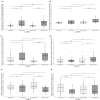Preliminary Study Using Wearable Near-Infrared Spectroscopy for Continuous Monitoring of Hemodynamics Through the Carotid Artery
- PMID: 40863009
- PMCID: PMC12384115
- DOI: 10.3390/bios15080549
Preliminary Study Using Wearable Near-Infrared Spectroscopy for Continuous Monitoring of Hemodynamics Through the Carotid Artery
Abstract
Non-invasive, continuous monitoring of carotid artery hemodynamics may provide valuable insights on cerebral blood perfusion (CBP). Near-infrared spectroscopy (NIRS) is a non-invasive modality that may be a good candidate for real-time carotid artery monitoring. We designed a wearable NIRS system to monitor the left and right radial and carotid arteries in 20 healthy subjects. The changes in total hemoglobin concentration (HbT) and tissue oxygen saturation (StO2) in all 80 arteries were continuously monitored in response to changes in oxygen supply. Wilcoxon non-parametric equivalence testing was used to compare changes in the radial (reference) and carotid arteries. The system-derived HbT and StO2 trends matched the expected physiological responses over time in the radial and carotid arteries. The mean peak-to-peak amplitude [uM] of HbT during sustained deep breathing was practically equivalent between the left radial (0.9 ± 0.8) and left carotid (1.6 ± 1.1) arteries (p = 0.01). The mean peak-to-peak amplitude [%] of StO2 was practically equivalent between the left radial (0.3 ± 0.2) and left carotid (0.3 ± 0.2) arteries (p < 0.001) and the right radial (0.4 ± 0.5) and right carotid (0.5 ± 0.4) arteries (p = 0.001). These findings indicate that NIRS may be a good option for monitoring the carotid arteries to track changes in CBP.
Keywords: Biophotonics; carotid artery; hemodynamics; near-infrared spectroscopy; tissue oxygen saturation.
Conflict of interest statement
All authors are inventors on PCT patent application no. PCT/US2024/038690. NM and LS own shares of CaroRhythm, Inc, and NM is the acting CEO of CaroRhythm, Inc.
Figures




References
-
- Qaja E., Tadi P., Theetha Kariyanna P. StatPearls. StatPearls Publishing; Treasure Island, FL, USA: 2025. Symptomatic Carotid Artery Stenosis. - PubMed
MeSH terms
Substances
Grants and funding
LinkOut - more resources
Full Text Sources

